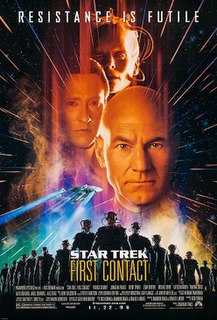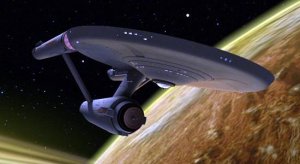
Star Trek: The Next Generation (TNG) is an American science fiction television series created by Gene Roddenberry. It originally aired from September 28, 1987 to May 23, 1994 in syndication, spanning 178 episodes over seven seasons. The third series in the Star Trek franchise, it is the second sequel to Star Trek: The Original Series. Set in the 24th century, when Earth is part of the United Federation of Planets, it follows the adventures of a Starfleet starship, the USS Enterprise (NCC-1701-D), in its exploration of the Milky Way galaxy.

Star Trek: First Contact is a 1996 American science fiction film directed by Jonathan Frakes and based on the franchise Star Trek. It is the eighth film in the Star Trek film series, the second to star the cast of Star Trek: The Next Generation. In the film, the crew of the USS Enterprise-E travel back in time from the 24th century to the mid-21st century to stop the cybernetic Borg from conquering Earth by changing their past.

Enterprise or USS Enterprise is the name of several fictional spacecraft, some of which are the main craft and setting for various television series and films in the Star Trek science fiction franchise. The most notable were Captain James T. Kirk's USS Enterprise (NCC-1701) from the original 1960s television series, and Captain Jean-Luc Picard's USS Enterprise (NCC-1701-D) from Star Trek: The Next Generation.

USS Voyager(NCC-74656) is the fictional Intrepid-class starship which is the primary setting of the science fiction television series Star Trek: Voyager. It is commanded by Captain Kathryn Janeway. Voyager was designed by Star Trek: Voyager production designer Richard D. James and illustrator Rick Sternbach. Most of the ship's on-screen appearances are computer-generated imagery (CGI), although models were also sometimes used. The ship's motto, as engraved on its dedication plaque, is a quote from the poem "Locksley Hall" by Alfred, Lord Tennyson: "For I dipt in to the future, far as human eye could see; Saw the vision of the world, and all the wonder that would be."
In the Star Trek franchise, the Klingon Empire makes use of several classes of starships. As the Klingons are portrayed as a warrior culture, driven by the pursuit of honor and glory, the Empire is shown to use warships almost exclusively and even their support ships, such as troop transports and colony ships, are armed for battle. This contrasts with the exploration and research vessels used by Starfleet, the protagonists of the franchise. The first Klingon ship design used in The Original Series, the D7-class battlecruiser, was designed by Matt Jefferies to evoke a shape akin to that of a manta ray, providing a threatening and instantly recognizable form for viewers. The configuration of Jefferies's design featured a bulbous forward hull connected by a long boom to a wing-like main hull with the engine nacelles mounted on each wingtip. Though a variety of Klingon ships have appeared in Star Trek, their design generally conforms to this style. Most Klingon vessels were physically built as scale models, although later computer-generated imagery was used to create the models. In recent years, many of the original studio models have been sold at auctions.

Mr. Scott's Guide to the Enterprise, written and illustrated by Lora Johnson, known as Shane Johnson at that time, is a book describing the post-refit USS Enterprise from the Star Trek fictional universe. It is written from the viewpoint of the ship's chief engineer, Montgomery Scott. The manual was first printed and published by Pocket Books in 1987.

USS Enterprise (NCC-1701) is a starship in the Star Trek media franchise. It is the main setting of the original Star Trek television series (1966–69), and it is depicted in spinoffs, films, books, products, and fan-created media. Under the command of Captain James T. Kirk, the Enterprise carries its crew on a mission "to explore strange, new worlds; to seek out new life and new civilizations; to boldly go where no man has gone before." The 2022 spinoff Star Trek: Strange New Worlds depicts the Enterprise under the command of Kirk's predecessor, Captain Christopher Pike.

USS Enterprise (NCC-1701-D), or Enterprise-D, is a starship in the Star Trek media franchise. Under the command of Captain Jean-Luc Picard, it is the main setting of Star Trek: The Next Generation (1987–1994) and the film Star Trek Generations (1994). It has also been depicted in various spinoffs, films, books, and licensed products.

Enterprise NX-01 is a fictional spaceship that appears in the American science fiction television series Star Trek: Enterprise. It had the in-universe registration of NX-01 and appeared earlier in the franchise timeline than any other Starfleet ship named Enterprise.
The Star Trek franchise has produced a large number of novels, comic books, video games, and other materials, which are generally considered non-canon.
Shuttlecraft are fictional vehicles in the Star Trek science fiction franchise built for short trips in space, such as between a planetary surface and orbit. Also referred to as shuttles, their introduction preceded the development of the Space Shuttle.

Michael Okuda is an American graphic designer best known for his work on Star Trek including designing futuristic computer user interfaces known as "okudagrams".
Richard Michael Sternbach is an illustrator who is best known for his space illustrations and his work on the Star Trek television series.
Franz Joseph was an artist and author loosely associated with the 1960s American television show Star Trek.

Star Trek: The Next Generation: Technical Manual is a paperback reference guide detailing the inner and other workings of the fictional Federation starship Enterprise-D and other aspects of technology that appeared in the television series Star Trek: The Next Generation.
Star Trek is an American science fiction media franchise created by Gene Roddenberry, which began with the eponymous 1960s television series and quickly became a worldwide pop-culture phenomenon. The franchise has expanded into various films, television series, video games, novels, and comic books. With an estimated $10.6 billion in revenue, it is one of the most recognizable and highest-grossing media franchises of all time.

The Star Trek franchise features many spacecraft. Various space vessels make up the primary settings of the Star Trek television series, films, and expanded universe; others help advance the franchise's stories. Throughout the franchise's production, spacecraft have been depicted by numerous physical and computer-generated models. Producers worked to balance often tight budgets with the need to depict convincing, futuristic vessels.

Star Trek Maps is a reference work demonstrating the stellar cartography and navigation system featured on the Star Trek television series, written from an in-universe perspective. It was published by Bantam Books in August 1980, and licensed by Paramount Pictures.











